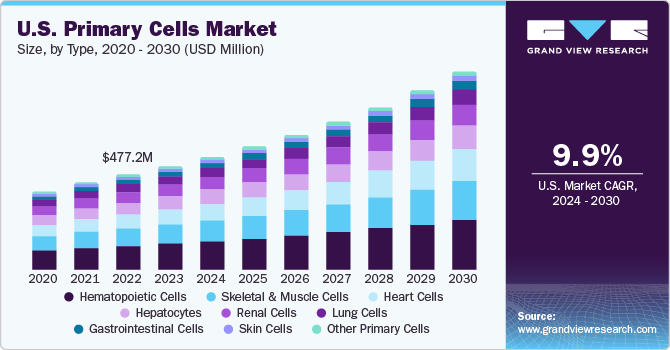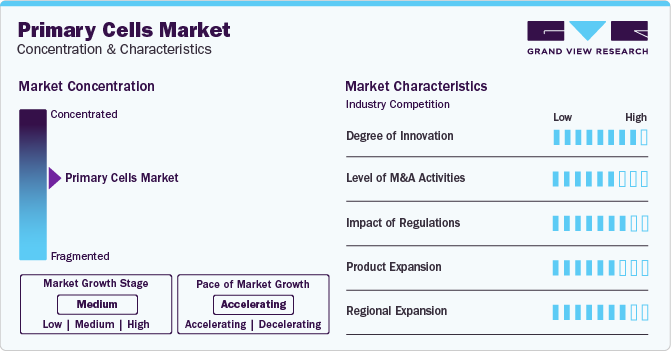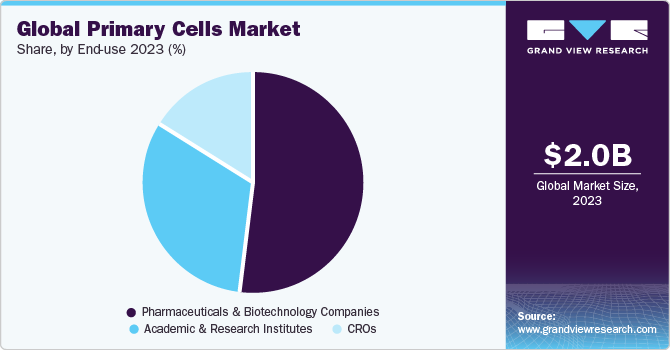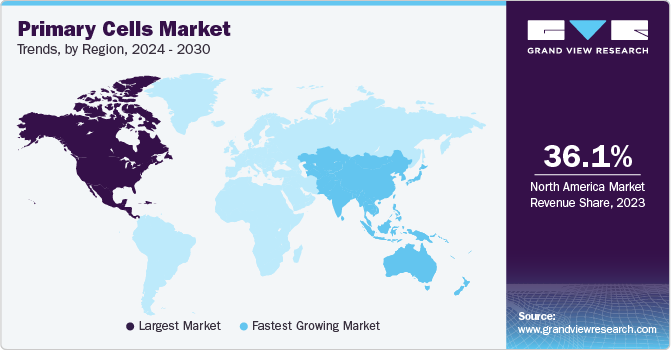
Primary Cells Market Size, Share & Trends Analysis Report By Origin (Human, Animal), By Type (Hematopoietic Cells, Skin Cells, Gastrointestinal Cells), By Application (Regenerative Medicine), By End-use, By Region, And Segment Forecasts, 2024 - 2030
- Report ID: GVR-4-68040-303-8
- Number of Report Pages: 120
- Format: PDF
- Historical Range: 2018 - 2023
- Forecast Period: 2024 - 2030
- Industry: Healthcare
Primary Cells Market Size & Trends
The global primary cells market size was estimated at USD 2.02 billion in 2023 and is projected to grow at a CAGR of 10.39% from 2024 to 2030. This growth can be attributed to the increasing demand for monoclonal antibodies, increasing cancer research, rising number of pharmaceutical and biotechnology companies, growing advantages of primary human cells over cell lines, and increasing government initiatives for cell-based research.

Primary human cells offer numerous advantages over in vitro cell lines. They provide more dependable tissue-specific reactions in a biologically pertinent microenvironment, leading to more precise outcomes in drug response studies. Additionally, they are cost-effective and help minimize the necessity for animal models in research. Consequently, they are a preferred choice for pharmaceutical, biotechnology companies, and Contract Research Organizations (CROs). CROs specializing in cell-based assays can leverage the advantages of primary human cells to deliver high-quality data for drug discovery and development projects. By incorporating these into their services, CROs can enhance the accuracy and translatability of preclinical studies, ultimately improving the success rate of drug candidates in clinical trials.
Primary cells played an important role in understanding COVID-19 pathogenesis, identifying therapeutic targets, and evaluating vaccine candidates. The cells derived from human lung tissue are essential in studying SARS-CoV-2, the virus responsible for COVID-19. Researchers have used them to investigate how the virus infects lung tissue, triggers immune responses, and causes respiratory symptoms.
Monoclonal antibodies have gained prominence in various therapeutic applications due to their specificity and effectiveness in targeting specific antigens. Primary cells play a significant role in the development and testing of monoclonal antibodies, driving their demand in the market. In addition, the burden of cancer is a growing concern. With approximately 20 million new cases and 9.7 million reported deaths in 2022, the increasing cancer research and demand for raw materials will further propel the market forward. Primary cells are important in studying cancer biology, developing new oncology treatments, and personalizing therapies based on individual patient characteristics. Their use in oncology research is driven by the growing emphasis on understanding tumor microenvironments and genetic diversity.
Moreover, government investments in cell-based research have also fueled the market. Governments worldwide are allocating funds to support research initiatives focused on cell-based therapies, regenerative medicine, and personalized medicine. This financial support encourages innovation and advancements in primary cell research, contributing to industry growth.
Furthermore, the rising growth in the pharmaceutical and biotechnology industries propel the market growth. These industries heavily rely on primary cells for drug discovery, toxicity testing, disease modeling, and personalized medicine approaches. The increasing focus on precision medicine and targeted therapies further boosts the demand for these cells in R&D activities.
Market Concentration & Characteristics
The global market is characterized by a high degree of innovation driven by technological advancements and an increasing demand for more reliable cellular models in biomedical research. The biomedical industry is experiencing remarkable progress due to ongoing advancements in cell isolation techniques, preservation methods, and quality control measures. These advances are enhancing primary cells to be more physiologically relevant and accurate models for studying human biology and disease, ultimately leading to better patient outcomes. Additionally, integrating them with emerging technologies, such as organ-on-a-chip systems and 3D bioprinting, holds great promise for advancing drug discovery, toxicology screening, and personalized medicine.

The industry is also characterized by a moderate level of merger and acquisition activities undertaken by several key players. This is due to several factors, including the desire to gain a competitive advantage in the industry and the need to consolidate in a rapidly growing market. For instance, in January 2024, STEMCELL Technologies announced the acquisition of Propagenix, Inc. By this acquisition, STEMCELL Technologies expanded its product portfolio and is able to offer Propagenix, Inc.’s technology to researchers involved in the R&D for the treatment of cancer, respiratory diseases, and other disorders.
GMP regulations are essential for ensuring that primary cells used in pharmaceutical and biotechnological applications meet specific quality standards. Compliance with GMP guidelines is important for maintaining consistency in cell culture processes, minimizing contamination risks, and ensuring the reproducibility of experimental results.
Key companies are strategically focusing on increasing production capacity and improving their portfolios to expand in diverse geographic areas. Moreover, the rising demand for therapeutic antibodies in treating chronic diseases expedites the research and development in cellular and molecular biology, fostering companies’ product portfolios. For instance, in November 2023, Lonza announced the launch of an increased-potency cell line-GS Effex to develop therapeutic antibodies. This cell line is derived from Lonza’s GS Xceed cell line.
Origin Insights
The human primary cells segment dominated the market with the largest share of 63.30% in 2023. They are essential in R&D as they closely resemble the physiological state of cells in vivo, thereby providing more biologically relevant data than immortalized cell lines. Their inclusion in cell culture systems significantly enhances the physiological relevance of the generated data, thereby enabling researchers to obtain valuable insights that are more closely aligned with in vivo outcomes.
This segment is also expected to grow at the fastest CAGR over the forecast period. Using these cells over immortalized cell lines offers several advantages, such as biological relevance by maintaining key aspects of their tissue origin better than continuously passaged cell lines, donor variability representation, and predictive data generation.
Moreover, animal cells are essential for studying various biological processes and diseases in vitro. The primary cultures derived from different animal tissues closely mimic the physiological state of cells in vivo and provide valuable insights into cellular functions. Animal primary cells have benefits in physiological relevance, disease modeling, and research applications. They are utilized in a wide range of R&D, such as cancer biology, drug development, toxicology studies, and regenerative medicine.
End-use Insights
The pharmaceuticals & biotechnology companies segment observed a lucrative growth in terms of revenue in 2023. Primary cells are vital tools in pharmaceutical and biotechnology companies for drug discovery, disease modeling, toxicology studies, high-throughput screening projects, and personalized medicine initiatives. For instance, in April of 2023, AnaBios Corporation acquired Cell Systems, a prominent U.S.-based human primary cell and cell culture media company. This acquisition is expected to significantly bolster AnaBios' portfolio of human tissues and cells, providing scientists with an extensive array of biologically relevant tools to expedite drug discovery and enhance their understanding of cell biology.

Additionally, they are utilized in screening compounds for efficacy and safety profiles before advancing to clinical trials. They are also used to assess the safety profiles of new drugs by studying their effects on human tissues without relying solely on animal models. Their physiological relevance helps identify potential drug candidates with higher success rates.
The academic and research institutes segment is expected to grow at the fastest CAGR over the forecast period. In academic and research institutes, primary cells are essential in advancing scientific knowledge and understanding various biological processes. They offer researchers a more accurate representation of in vivo cellular behavior than immortalized cell lines. These freshly isolated cells maintain their physiological properties and closely mimic the tissue microenvironment, providing valuable insights into cell function, disease mechanisms, drug responses, and therapeutic development.
Type Insights
The hematopoietic cells segment accounted for the largest market share of 25.27% in 2023, owing to their importance in the research and development of regenerative medicines. These multipotent primitive cells have the ability to develop into all types of blood cells, including myeloid-lineage and lymphoid-lineage cells. Researchers are actively exploring the use of adult-derived Hematopoietic Stem Cells (HSCs) in clinical and basic science applications due to their diverse feasibility and importance in stem cell biology. HSCs and their derived progenitors are important sources in regenerative medicine, offering potential treatments for various pathophysiologic conditions, including non-hematopoietic tissue regeneration and blood disorders. The plasticity of HSCs allows them to differentiate into diverse progenitors, making them valuable tools for developing effective therapeutic strategies.
The skeletal and muscle cells segment is expected to grow at the fastest CAGR over the forecast period owing to their use in the study of satellite cell function and regeneration mechanisms as potential therapeutic targets for muscular dystrophies. A team of researchers from King's College London and University College London have recently published their findings on a novel tool that employs images to effectively identify the optimal cells for implantation, which could potentially aid in repairing damaged and diseased muscles.
Application Insights
The cancer research segment dominated the market with the largest share of 37.74% in 2023. The primary cells are significant in oncology R&D due to their physiological relevance, genetic diversity, and tumor microenvironment representation offered by them, and are also preferred over cell lines in R&D as they provide more accurate and reliable results, allowing researchers to study disease mechanisms and drug responses and develop targeted therapies for various types of cancer. The advantages of primary human cells, such as their ability to closely represent signaling in vivo, make them essential tools in oncology research.
The regenerative medicine segment is expected to grow at the fastest CAGR over the forecast period. Human primary cells play a substantial role in regenerative medicine due to their ability to closely mimic the in vivo biology of cells. These cells, isolated directly from human tissues, provide a more reliable and relevant representation of human biology compared to immortalized cell lines. In October 2020, Japanese pharmaceutical company Astellas Pharma opened its $120 million expanded Astellas Institute for Regenerative Medicine (AIRM) facility in Westborough, Massachusetts.
Regional Insights
North America dominated the market and accounted for a 36.11% share in 2023 owing to the growing investments in the R&D of cancer research. Due to the presence of several biotechnology and pharmaceutical companies working on developing new therapies for cancer and chronic diseases, the region is projected to maintain its dominance over the projected period.

U.S. Primary Cells Market Trends
The primary cells market in the U.S. is experiencing significant trends that are shaping its growth and development. One of the key trends in the U.S. market is the increasing focus on personalized medicine and precision oncology. With advancements in technology and research, there is a growing emphasis on using primary cells to develop targeted therapies for individual patients based on their genetic makeup and specific disease characteristics.
Europe Primary Cells Market Trends
Europe industry is projected to witness significant growth driven by factors such as the increasing prevalence of chronic diseases due to lifestyle factors and advancements in cell therapy research for treating various conditions affecting human organ systems.
The UK primary cells market is observed to be a lucrative market in the region owing to the extensive investments and initiatives in the field of stem cell engineering and regenerative medicine. The UK Regenerative Medicine Platform (UKRMP) was established to support research and development in regenerative medicine. Additionally, Cancer Research UK allocates a significant portion of its funding to cancer research projects. Around 40% of its research expenditure focuses on basic laboratory research into the molecular basis of cancer. The remaining funds support research into specific cancer types, drug discovery and development, prevention, early detection, imaging, surgery, radiotherapy, and cancers with low survival rates.
The primary cells market in Germany is affluent in the global pharmaceutical and biotechnology industry. The development of potential cancer medicines and treatments is boosting the primary cells market in Germany. The country’s strong emphasis on biomedical research and advancements in cancer treatment using these cells further propel market growth. The utilization of patient-derived samples for cutting-edge preclinical technologies and the preference for primary human cells over animal cells for cancer research are significant trends influencing the market dynamics.
The France primary cells market is likely influenced by advancements in biomedical research, increasing demand for personalized medicine, and the emphasis on using more biologically relevant models for drug discovery and toxicity testing.
The French Government has made a total investment of USD 7.98 billion in the Health Innovation Plan 2030, aiming to fight emerging diseases and produce biomedicine to treat cancer and chronic diseases. In addition, Business France supports 11 French healthcare companies in expanding their network in Germany under the French Healthcare Booster Germany program.
Asia Pacific Primary Cells Market Trends
Asia Pacific is anticipated to witness the fastest growth at a CAGR of 12.50% from 2024 to 2030. The region is expected to witness substantial growth in the market, driven by factors such as increasing investments in healthcare infrastructure, rising cancer cases, and a growing focus on R&D activities related to cancer treatments and therapies.
China primary cells market has been witnessing a rapid increase in cancer cases, which has led to a surge in the demand for primary cells for cancer R&D. The country has also been investing heavily in healthcare infrastructure, biotechnology, and oncology to address the growing healthcare needs of its population.
Additionally, collaborations between Chinese research institutions, biopharmaceutical companies, and international partners have further propelled the growth of the primary cells market in China. These partnerships facilitate knowledge exchange, technology transfer, and joint research projects that aim to accelerate drug discovery and development processes using primary cell models. For instance, in March 2024, Merck KGaA announced its expansion of the M Lab Collaboration Center in Shanghai, aiding biopharmaceutical and biologics companies in developing optimal practices in manufacturing that save time and costs and increase the speed to market for life-saving therapies.
The primary cells market in Japan has a well-established biomedical R&D sector, which includes a focus on primary cell culture for various applications such as drug discovery, toxicity assessment, and personalized medicine. Abu Dhabi Stem Cells Centre (ADSCC) initiated a joint research agreement with Kyoto University's Center for iPS Cell Research and Application (CiRA) and Rege Nephro, a biotech company based in Japan in January 2024. The collaboration aims to revolutionize diabetes treatment by developing an innovative therapy using pancreatic beta cells derived from human-induced pluripotent stem cells (iPS cells). The ADSCC laboratory is launched at the premises of Kyoto University in Japan.
The India primary cells market is experiencing growth due to factors such as the increasing prevalence of chronic diseases, rising investments in healthcare infrastructure, and a growing focus on R&D activities.
Middle East and Africa Primary Cells Market Trends
The industry in Middle East and Africa is projected to grow in the near future due to the increasing applications of biotechnology in healthcare. One of the key trends in the Middle East and Africa primary cells market is the increasing focus on personalized medicine. With advancements in technology, researchers are now able to isolate primary cells from individual patients, allowing for more personalized treatment approaches. This trend is expected to drive their demand in the region as healthcare providers look for more effective and targeted therapies.
Saudi Arabia primary cells market is expected to witness growth in the utilization of primary cells for scientific research, drug discovery, and biotechnology. The Saudi Arabian healthcare sector continues to evolve and invest in advanced technologies. It is likely to experience a growing need for primary cells for applications ranging from disease modeling to personalized medicine initiatives.
The primary cell market in UAE is reflected by increasing investments in oncology. For instance, in December 2022, Al Jalila Foundation announced the launch of new cycle grants to support cancer research in the UAE.
Key Primary Cells Company Insights
Key players operating in the primary cells market are undertaking various initiatives to strengthen their market presence and increase the reach of their products and services. Strategies such as expansion activities and partnerships are playing a key role in propelling the market growth.
Key Primary Cells Companies:
The following are the leading companies in the primary cells market. These companies collectively hold the largest market share and dictate industry trends.
- Thermo Fisher Scientific
- Merck KGaA
- Lonza
- Cell Biologics, Inc.
- PromoCell
- ZenBio
- STEMCELL Technologies
- AllCells
- American Type Culture Collection
- Axol Biosciences Ltd.
Recent Developments
-
In March 2024, Axol Bioscience Ltd. Launched the axoCells Atrial Cardiomyocyte kit for in-vitro arrhythmia and cardiotoxicity research.
-
In February 2024, Merck KGaA announced the opening of its new distribution center in Brazil to support the country’s growing need for life science products.
-
In October 2023, STEMCELL Technologies announced its expansion by opening a new sales office in Toronto. This expansion is likely to strengthen STEMCELL Technologies' ties in the Toronto area and grow its North American presence.
-
In October 2021, Thermo Fisher Scientific launched a system that enables large-scale growth and culture of functional NK cells with or without feeder cells for cell therapy.
-
In February 2019, Lonza and AllCells partnered for the global commercialization of hematopoietic primary cells.
Primary Cells Market Report Scope
|
Report Attribute |
Details |
|
Market size value in 2024 |
USD 2.21 billion |
|
Revenue forecast in 2030 |
USD 4.00 billion |
|
Growth rate |
CAGR of 10.39% from 2024 to 2030 |
|
Historical data |
2018 - 2023 |
|
Forecast period |
2024 - 2030 |
|
Quantitative units |
Revenue in USD million/billion and CAGR from 2024 to 2030 |
|
Report coverage |
Revenue forecast, company ranking, competitive landscape, growth factors, and trends |
|
Segments covered |
Origin, type, application, end-use, region |
|
Regional scope |
North America; Europe; Asia Pacific; Latin America; MEA |
|
Country scope |
U.S.; Canada; Mexico; Germany; UK; France; Italy; Spain; Denmark; Sweden; Norway; China; Japan; India; South Korea; Australia; Thailand; Brazil; Argentina; South Africa; Saudi Arabia; UAE; Kuwait |
|
Key companies profiled |
Thermo Fisher Scientific; Merck KGaA; Lonza; Cell Biologics, Inc.; PromoCell; ZenBio; STEMCELL Technologies; AllCells; American Type Culture Collection; Axol Biosciences, Ltd. |
|
Customization scope |
Free report customization (equivalent up to 8 analyst’s working days) with purchase. Addition or alteration to country, regional & segment scope. |
|
Pricing and purchase options |
Avail customized purchase options to meet your exact research needs. Explore purchase options |
Global Primary Cells Market Report Segmentation
This report forecasts revenue growth at global, regional, and country levels and provides an analysis of the latest industry trends in each of the sub-segments from 2018 to 2030. For this study, Grand View Research has segmented the global primary cells market report based on origin, type, application, end-use, and region:
-
Origin Outlook (Revenue, USD Million, 2018 - 2030)
-
Human Primary Cells
-
Animal Primary Cells
-
-
Type Outlook (Revenue, USD Million, 2018 - 2030)
-
Hematopoietic Cells
-
Skin Cells
-
Hepatocytes
-
Gastrointestinal Cells
-
Lung Cells
-
Renal Cells
-
Heart Cells
-
Skeletal and Muscle Cells
-
Other Primary Cells
-
-
Application Outlook (Revenue, USD Million, 2018 - 2030)
-
Drug Discovery and Development
-
Regenerative Medicine
-
Cancer Research
-
Others
-
-
End-use Outlook (Revenue, USD Million, 2018 - 2030)
-
Pharmaceuticals & Biotechnology Companies
-
Academic & Research Institutes
-
CROs
-
-
Regional Outlook (Revenue, USD Million, 2018 - 2030)
-
North America
-
U.S.
-
Canada
-
Mexico
-
-
Europe
-
Germany
-
UK
-
France
-
Italy
-
Spain
-
Denmark
-
Sweden
-
Norway
-
-
Asia Pacific
-
China
-
Japan
-
India
-
South Korea
-
Australia
-
Thailand
-
-
Latin America
-
Brazil
-
Argentina
-
-
MEA
-
South Africa
-
Saudi Arabia
-
UAE
-
Kuwait
-
-
Frequently Asked Questions About This Report
b. The global primary cells market size was estimated at USD 2.02 billion in 2023 and is expected to reach USD 2.21 billion in 2024.
b. The global primary cells market is expected to grow at a compound annual growth rate of 10.39% from 2024 to 2030 to reach USD 4.00 billion by 2030.
b. North America dominated the market and accounted for a 36.11% share in 2023 owing to the growing investments in the R&D of cancer research.
b. Some key players operating in the primary cells market include Thermo Fisher Scientific; Merck KGaA; Lonza; Cell Biologics, Inc.; PromoCell; ZenBio; STEMCELL Technologies; AllCells; American Type Culture Collection; Axol Biosciences, Ltd.
b. This growth can be attributed to the increasing demand for monoclonal antibodies, increasing cancer research, rising number of pharmaceutical and biotechnology industries, growing advantages of primary human cells over cell lines, and increasing government initiatives for cell-based research.
We are committed towards customer satisfaction, and quality service.
"The quality of research they have done for us has been excellent."




